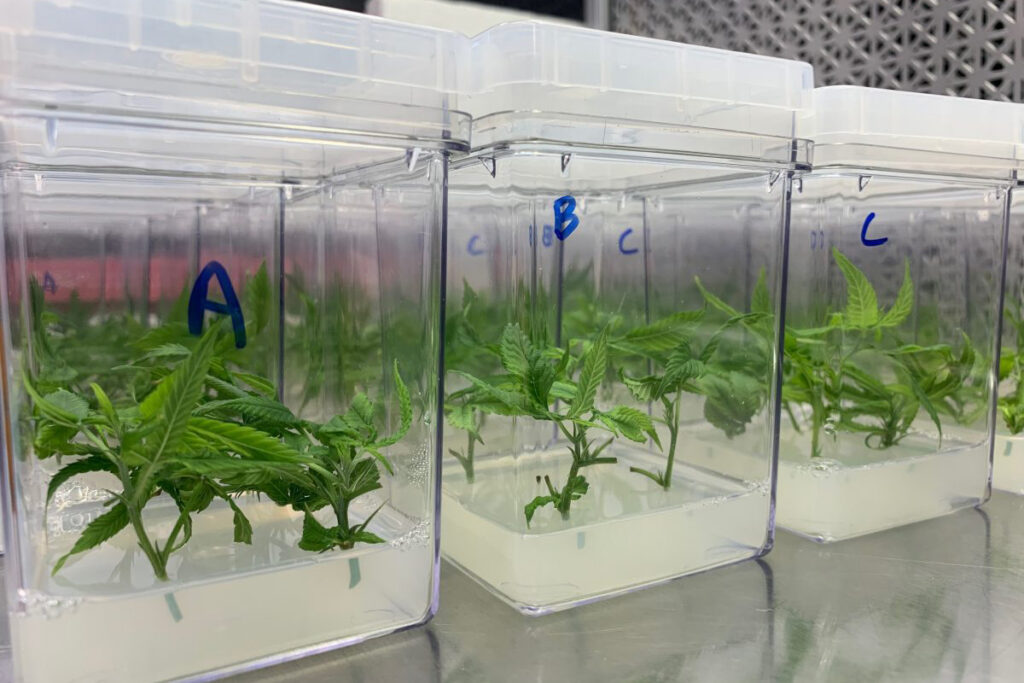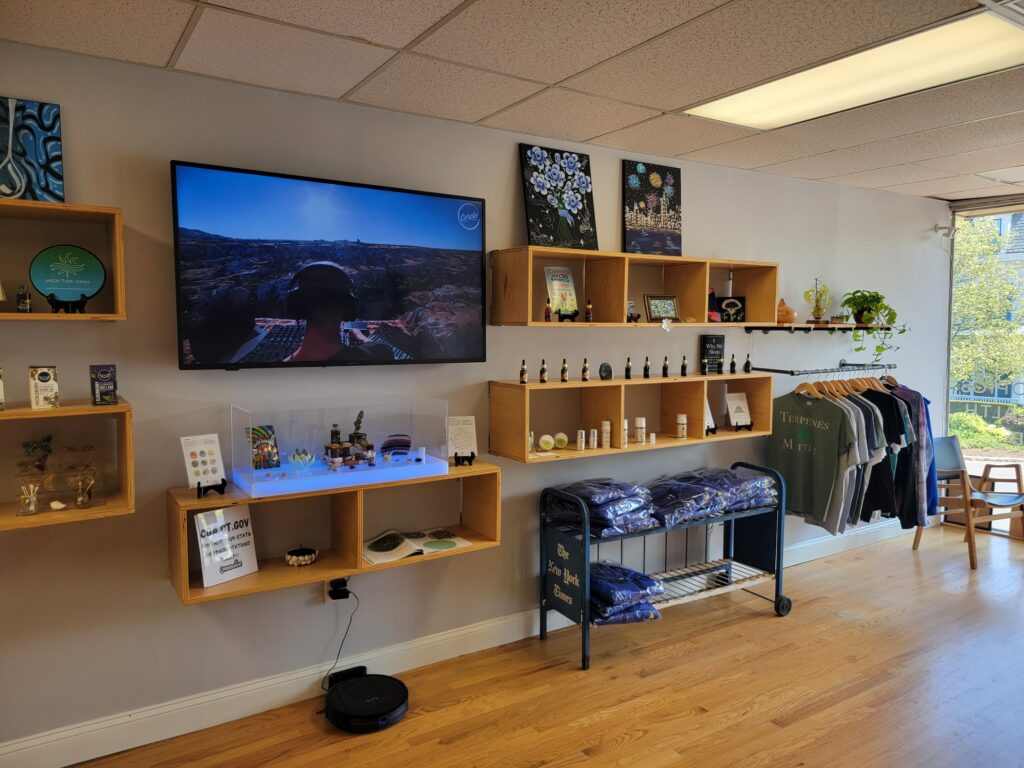A surgical complication in 2010 almost led Duncan Markovich, the owner and co-founder of the CBD store Better Ways in Brandford, CT, to lose his left leg. He began using cannabis therapeutically to relieve pain and treat nerve damage.
After the 2018 Farm Bill descheduled some cannabis products from the Controlled Substance Act, Markovich and his friend Paul decided to open a CBD store that would sell plant-based health and wellness products will THC levels no higher than 0.3%. In 2019, the doors were open to the public.
“We opened the store in April 2019 to help focus on educating the community, the benefits of cannabis and its cautions, the signs of how it works with our bodies as a plant-based medicine, good sourcing of products from the US only that have lab results and then also making sure affordability with the community,” Markovich said.
Markovich is also a cannabis activist who regularly speaks with local legislators working to pass bills to increase cannabis accessibility and research. He often posts the bills to the Instagram so his followers are aware of the current laws circling the state legislature.
“Without knowledge people don’t have the power,” Markovich said. “The power to make a decision to be well informed so whether that’s somebody within the community that was a patient… how are they going to acknowledge activists.”
For thousands of years, people have used the cannabis plant in ritual practices, to treat diseases and disorders and for recreation. However, within the past century, the plant is now being used to target people of color and marginalized communities by taxing it making it unaffordable and ultimately led to federal illegalization.
The demonization of cannabis goes as far back as the 1930s when Harry Anslinger, the first head of the now-disbanded Federal Bureau of Narcotics, led a national campaign against the plant spewing blatant racism toward the Black and Latino communities and laid the foundation for strong legislation against cannabis. In 1937, the Tax Act passed making marijuana illegal in all states.
Hillary Haldane, a Quinnipiac University professor of anthropology teaching the university’s first course on cannabis, says the demonization within the past 100 years reveals why the plant is socially, culturally and morally challenged.
“It was another way of being racist without it being about the individuals themselves,” Haldane said. “He was one of the people who very strategically and creatively and successfully made the stigma about substances and race, this whole culture of fear and culture of the downfall of our society is wrapped up in these substances, which are controlled by these people who have melanin.”

Former Mayor of New York City Fiorello La Guardia commissioned the New York Academy of Medicine in 1938 to conduct some of the first research on marijuana. In 1944, the La Guardia Committee report found that cannabis was not physically addictive, a gateway drug or did it lead to crime. This report was one of the first times a large body questioned the prohibition of marijuana. In response to the report, Anslinger labeled it as unscientific, a tactic that current politicians still claim despite the evidence.
Marijuana remained banned until the Supreme Court case Leary v. United States where the Tax Act became illegal saying that purchasing a marijuana stamp, which was required to have if an individual or business wanted to grow, is self-incriminating. The Tax Act was then rolled back and revised to the Controlled Substance Act of 1970. Since this ruling, cannabis has been labeled a Schedule I drug making it, according to the Drug Enforcement Administration, a more dangerous drug than cocaine and methamphetamine, which are both classified as a Schedule II drug.
The slow wave of cannabis legalization
California became the first state to legalize marijuana for medicinal purposes in 1996. This led other states to slowly pass legislation allowing medical marijuana to be purchased and grown.
The first action to decriminalize marijuana in Connecticut was in 2011. A bill that narrowly passed the state Senate decriminalized possession of less than a half ounce.
A year later, Connecticut became the 17th state to legalize medical marijuana.
In 2015, the state legislature voted to decriminalize the possession of recreational marijuana. First offense fines would not exceed $150.
Ten years after legalizing medical marijuana, Gov. Ned Lamont signed the bill into law making it legal for recreational use. Lamont reaffirmed that Connecticut should be an example of legalizing cannabis correctly.
“We had a chance to learn from others and I think we’ve got it right here in the state Connecticut. Maybe we weren’t the first, but we were the first I think to show that we can get it right,” Gov. Ned Lamont said in a conference after signing the bill into law on July 1, 2021.
After climbing the hill to make recreational cannabis usage legal, access to the plant continues to explode across the country. On Jan. 10 2023, dispensaries opened to the public. Beginning on July 1, 2023, people over the age of 21 can grow six THC cannabis plants at home; 12 plants per household.
The landscape for research has also immensely improved within the past decade. Owner of Better Ways Markovich says the industry probably moves three to five times faster than any other, which is why people need to work with local politicians to ensure politics are moving at the same pace.
“It’s really imperative that anybody who is connected to the cannabis industry… that everybody gets talking to their legislators, not just their local legislators to get your ideas out there more,” he said.
Progress in legalization has swept many states, but the racial disparities linked to the long history of the plant still remain.
According to a report by the American Civil Liberties Union, arrests for marijuana possession have decreased by 18% since 2010. Of all drug-related arrests across the country, 89.6% are for marijuana possession. Black people are 3.64 times more likely than white people to get arrested for possession, which has remained unchanged since 2010.
While Connecticut continues to progress in cannabis legalization, there is still a strong lack of awareness and action in the justice system. The state is higher than the national average in arresting Black people for marijuana possession than white people.
The same report states that Black people in New London county are 9.06 times more likely to be arrested than white people. Tolland county follows closely behind at 8.78.
“With substances I think, even if it were to be legal, full stop across the United States, like for recreational too,” Haldane said. “I just think there’s still that power of that kind of moral judgment of us who’s allowed to use it and when and who would be stigmatized?”
Changing the culture at universities
As the doors open to cannabis accessibility, a looming history still hangs over the community. Haldane believes universities could be a place to begin removing the stigma.
“A university’s job is to ensure that all people are seen as equally valid and worthy of good in the world, and of support in the world as any other and if a university is perpetuating harmful stereotypes about people because of their use of something then we are not serving society,” she said.
In her new course on cannabis, Haldane aims to address the relationship between the plant and the rest of the world. With cannabis legalized across the state, she felt that students could feel more comfortable and honest to have a conversation about the plant.
“I do think we have a responsibility to be a resource of knowledge and education,” Haldane said. “It should be a place where people can speak openly about their experiences and that might be people who have had terrible experiences with cannabis.”
Other universities across Connecticut are also providing opportunities to research cannabis. Eastern Connecticut State University (ESCU) developed a “Cannabis Cultivation and Chemistry” minor in 2020 that provides hands-on and theoretical approaches to train students to cultivate.
“Our big claim to fame is that we have a lot of hands on, and our administration really supports it and supports the program,” said Brian Connolly, an ECSU professor of biology.
Discussing culture is not a part of the curriculum at, but Connolly says he still thinks it is significant to discuss the archaeology of the plant including people using it for thousands of years and the usage when it was legalized all the way until the Tax Act.
Connolly applied for and received a license from the state so ECSU students can learn the process of cannabis cultivation. He says students work alongside him in growing, fertilizing, harvesting, trimming and drying the plant. Since the program is so small, each student has a few plants to work with.
“We are hoping that this would be job training for the new market that’s opening up and also just to educate students about what is CBD? What is THC?” Connolly said.
ECSU students can also acquire a certification for environmentally sustainable cannabis businesses in partnership with the New England Sustainable Cannabis Certification.

The University of Connecticut’s College of Agriculture, Health and Natural Resources (CAHNR) is a national leading cannabis research program that has received more than $1 million in sponsored funding.
The university launched the nation’s first cannabis horticulture course in 2019 and a cannabis cultivation minor this year. Dean of the College of Agriculture, Health and Natural Resources Indrajeet Chaubey hopes that their research opportunities will lead students to legitimate business opportunities.
“Since the first course launched, we have added courses, certificates and conferences to give students opportunities to put their knowledge into action,” Chaubey said.
Students like Andrew Lemire, a senior health science studies major from Groton, CT, say that universities should act as a resource to students as legislation passes across the country.
“As recreational usage becomes more popular around the country, it presents an opportunity to be a leader in education,” Lemire said. “I do not feel that the university has a requirement to serve in this purpose, although it serves to benefit students.”
As the political landscape surrounding cannabis continues to expand, Quinnipiac’s Haldane emphasizes the need for educational institutions to continue opportunities for students and that stigma shouldn’t hold back students from going into the cannabis industry.
“I think a university doesn’t necessarily need to endorse cannabis,” Haldane said. “I think a university needs to endorse the humanity of every single person, whether or not they use cannabis. And I think that that’s our job as an institution of higher education. I do think though, the university should be a site of education for people who want to go into this as a legitimate business opportunity.”



